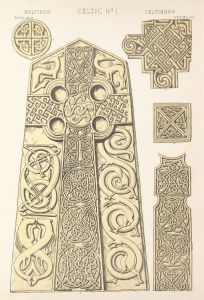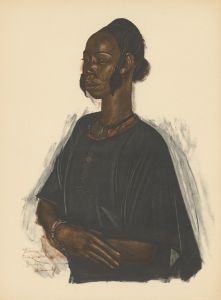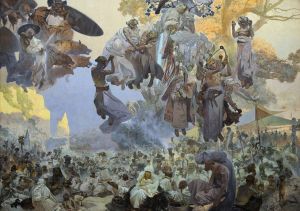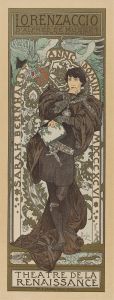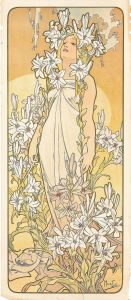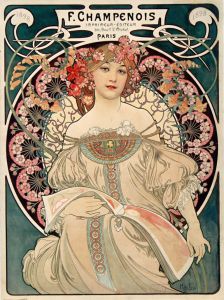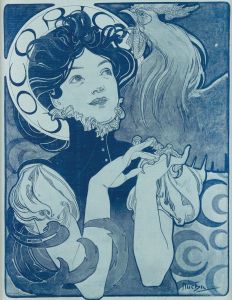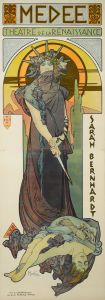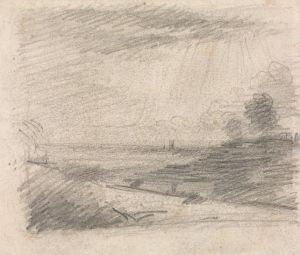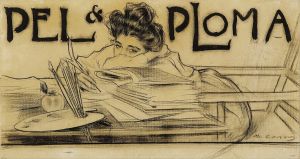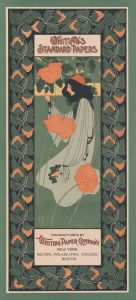
Carton de vitrail pour la bijouterie Fouquet
A hand-painted replica of Alphonse Mucha’s masterpiece Carton de vitrail pour la bijouterie Fouquet, meticulously crafted by professional artists to capture the true essence of the original. Each piece is created with museum-quality canvas and rare mineral pigments, carefully painted by experienced artists with delicate brushstrokes and rich, layered colors to perfectly recreate the texture of the original artwork. Unlike machine-printed reproductions, this hand-painted version brings the painting to life, infused with the artist’s emotions and skill in every stroke. Whether for personal collection or home decoration, it instantly elevates the artistic atmosphere of any space.
Alphonse Mucha, a Czech painter and decorative artist, is renowned for his distinctive style that became synonymous with the Art Nouveau movement. One of his notable works is the "Carton de vitrail pour la bijouterie Fouquet," which translates to "Stained Glass Design for the Fouquet Jewelry Shop." This piece exemplifies Mucha's mastery in combining art with commercial design, a hallmark of his career.
The "Carton de vitrail" was created as a design for a stained glass window intended for the jewelry shop of Georges Fouquet, a prominent Parisian jeweler. Mucha and Fouquet's collaboration began in the late 19th century, during a period when Art Nouveau was at its peak. This partnership was significant as it brought together Mucha's artistic vision and Fouquet's craftsmanship, resulting in a series of works that were both commercially viable and artistically innovative.
Mucha's design for the Fouquet shop is characterized by its intricate patterns and flowing lines, typical of the Art Nouveau style. The design likely features natural motifs, such as flowers and plants, which were common elements in Mucha's work. These motifs are often intertwined with female figures, another signature aspect of Mucha's art. The use of vibrant colors and elaborate details in the stained glass would have created a captivating visual experience for the shop's visitors, enhancing the luxurious ambiance of Fouquet's jewelry store.
The collaboration between Mucha and Fouquet was not limited to stained glass designs. Mucha also designed the interior of Fouquet's shop, which opened in 1901 on Rue Royale in Paris. The shop's interior was a comprehensive Art Nouveau masterpiece, featuring furniture, light fixtures, and display cases all designed by Mucha. This holistic approach to design was revolutionary at the time and demonstrated Mucha's ability to extend his artistic vision beyond traditional canvases.
Mucha's work for Fouquet is a testament to his belief in the unity of art and design. He saw no distinction between fine art and applied art, a philosophy that was central to the Art Nouveau movement. By integrating his artistic style into commercial spaces, Mucha helped to elevate the status of decorative arts and demonstrated the potential for art to enhance everyday environments.
The "Carton de vitrail pour la bijouterie Fouquet" is an example of Mucha's ability to adapt his artistic style to different mediums and purposes. While the original stained glass may no longer exist, the design remains an important part of Mucha's legacy and the history of Art Nouveau. It reflects the innovative spirit of the era and Mucha's role in shaping the visual culture of the time.
Today, Mucha's work continues to be celebrated for its beauty and influence. His designs for Fouquet, including the stained glass, are studied as exemplary works of Art Nouveau and are appreciated for their artistic and historical significance. Through these works, Mucha has left an enduring impact on the world of art and design, inspiring future generations of artists and designers.






